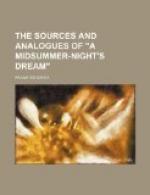[5] P. 93, l. 19. bolt, sift, pass through a sieve.
[6] P. 95, l. 5. himpen, hampen. Cf. “Hemton hamton” in Scot’s account of Robin, p. 135.
[7] P. 97, l. 18. night-raven, proverbially a bird of ill-omen.
[8] P. 98, l. 7. starkled, stiffened. A dialect word, still in use.
[9] P. 98, l. 22. quills, spools or “bottoms” on which weavers’ thread is wound.
[10] P. 101, l. 8. the tune of Watton Town’s End. See Chappell’s Popular Music, 218-20.
[11] P. 105, l. 18. bombasting, puffing up, frothing.
[12] P. 106, l. 1. Obreon. The 1639 edition spells the name in the ordinary way, but it may be noted that the Pepysian copy of the broadside ballad (p. 144), begins—
“From Obreon in fairyland.”
[13] P. 108, l. 16. the tune of What care I how fair she be? This is the tune to George Wither’s famous—
“Shall I wasting in despair
Die because a woman’s fair?”
See Chappell’s Popular Music, 315.
[14] P. 109, l. 5. the tune of The Spanish Pavin. (Pavin = Pavan.) See Chappell, op. cit., 240.
[15] P. 110, l. 13. the tune of The Jovial Tinker. See Chappell, op. cit., 187.
[16] P. 110, l. 25. ax = ask. The form “ax” was in use till the end of the sixteenth century, and continues in dialect.
[17] P. 111, l. 13. the tune of Broom. See Chappell, op. cit., 458; but this song does not fit the metre.
* * * *
The Romance of Thomas of Erceldoune.
(Fytte I.)
See pp. 45-7. In preparing the text, I have reduced in as simple a manner as possible the fifteenth-century spelling to modern forms. Dr. J.A.H. Murray’s parallel texts (see note on p. 46) have been consulted, but mainly I have followed the oldest of them—that of the Thornton MS. in Lincoln Cathedral Library. The footnotes explain all words save those that are or ought to be familiar to every reader.
[1] l. 1. endris, last.
[2] l. 6. meaned, moaned.
[3] l. 7. bered, sounded. The woodwale is some kind of wood-bird.
[4] l. 14. wrable and ivry, ? wriggle and twist, i.e. in the attempt to describe her.
[5] l. 17. See p. 54.
[6] Swilk, such.
[7] l. 21. roelle-bone; a commonplace in early poetry, as the material for saddles; meaning unknown.
[8] l. 24. crapotee, toad-stone.
[9] l. 32. overbegone, overlaid.
[10] l. 33. paytrell = poitrail, breast-leather of a horse; iral (?).
[11] l. 34. orphare = orferrie, goldsmith’s work.
[12] l. 38. raches, dogs.
[13] l. 39. halse, neck.
[14] l. 40. flane, arrow.




